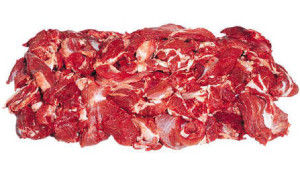The objective of this study was to determine the immediate source of Escherichia coli on beef trimmings produced at a large packing plant by analyzing the E. coli on trimmings at various locations of a combo bin filled on the same day and of bins filled on different days.
 Ten 2,000-lb (907-kg) combo bins (B1 through B10) of trimmings were obtained from a large plant on 6 days over a period of 5 weeks. Thin slices of beef with a total area of approximately 100 cm2 were excised from five locations (four corners and the center) at each of four levels of the bins: the top surface and 30, 60, and 90 cm below the top. The samples were enriched for E. coli in modified tryptone soya broth supplemented with 20 mg/liter novobiocin. The positive enrichment cultures, as determined by PCR, were plated on E. coli/coliform count plates for recovery of E. coli. Selected E. coli isolates were genotyped using multiple-locus variable-number tandem repeat analysis (MLVA).
Ten 2,000-lb (907-kg) combo bins (B1 through B10) of trimmings were obtained from a large plant on 6 days over a period of 5 weeks. Thin slices of beef with a total area of approximately 100 cm2 were excised from five locations (four corners and the center) at each of four levels of the bins: the top surface and 30, 60, and 90 cm below the top. The samples were enriched for E. coli in modified tryptone soya broth supplemented with 20 mg/liter novobiocin. The positive enrichment cultures, as determined by PCR, were plated on E. coli/coliform count plates for recovery of E. coli. Selected E. coli isolates were genotyped using multiple-locus variable-number tandem repeat analysis (MLVA).
Of the 200 enrichment cultures, 43 were positive by PCR for E. coli, and 32 of these cultures yielded E. coli isolates. Two bins did not yield any positive enrichment cultures, and three PCR-positive bins did not yield any E. coli isolates. MLVA of 165 E. coli isolates (30, 62, 56, 5, and 12 from B6 through B10, respectively) revealed nine distinct genotypes. MLVA types 263 and 89 were most prevalent overall and on individual days, accounting for 49.1 and 37.6% of the total isolates, respectively. These two genotypes were also found at multiple locations within a bin. All nine genotypes belonged to the phylogenetic group A0 of E. coli, suggesting an animal origin.
The finding that the trimmings carried very few E. coli indicates an overall effective control over contamination of beef with E. coli at this processing plant. The lack of strain diversity of the E. coli on trimmings suggests that most E. coli isolates may have come from common sources, most likely equipment used in the fabrication process.
Spatial and temporal distribution of Escherichia coli on beef trimmings obtained from a beef packing plant
01.aug.2016
Visvalingam, Jeyachchandran1; Wang, Hui1; Youssef, Mohamed K.2; Devos, Julia1; Gill, Colin O.1; Yang, Xianqin3
1: Agriculture and Agri-Food Canada, Lacombe Research Centre, 6000 C & E Trail, Lacombe, Alberta, Canada T4L 1W1 2: Agriculture and Agri-Food Canada, Lacombe Research Centre, 6000 C & E Trail, Lacombe, Alberta, Canada T4L 1W1, Department of Food Hygiene and Control, Faculty of Veterinary Medicine, Cairo University, Giza 11221, Egypt 3: Agriculture and Agri-Food Canada, Lacombe Research Centre, 6000 C & E Trail, Lacombe, Alberta, Canada T4L 1W1;, Email: xianqin.yang@agr.gc.ca
Journal of Food Protection, August 2016, Number 8, Pages 1325-1331, DOI: http://dx.doi.org/10.4315/0362-028X.JFP-15-598
http://www.ingentaconnect.com/content/iafp/jfp/2016/00000079/00000008/art00004


